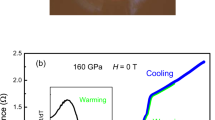Abstract
SINGLE crystals of cadmium sulphide less than 1000 Å thick have been studied in transmission in the electron microscope. Stacking faults similar to those observed in zinc sulphide have been discovered1. The crystals were grown from the vapour—the powder was heated at 900° C in a stream of argon at atmospheric pressure. Electron diffraction patterns showed the crystals to be of the wurtzite phase, plate-like parallel to (2&1bar;.0) as in the case of zinc sulphide crystals grown by the same technique.
This is a preview of subscription content, access via your institution
Access options
Subscribe to this journal
Receive 51 print issues and online access
$199.00 per year
only $3.90 per issue
Buy this article
- Purchase on Springer Link
- Instant access to full article PDF
Prices may be subject to local taxes which are calculated during checkout
Similar content being viewed by others
References
Chadderton, L. T., Fitzgerald, A. G., and Yoffe, A. D., Phil. Mag., 8, 85, 167 (1963).
Author information
Authors and Affiliations
Rights and permissions
About this article
Cite this article
CHADDERTON, L., FITZGERALD, A. & YOFFE, A. Stacking Faults in Cadmium Sulphide. Nature 198, 573–574 (1963). https://doi.org/10.1038/198573b0
Issue Date:
DOI: https://doi.org/10.1038/198573b0
This article is cited by
-
Control of the Thermoelectric Properties of Mg2Sn Single Crystals via Point-Defect Engineering
Scientific Reports (2020)
-
Defects in epitaxial films of semiconducting compounds with the sphalerite structure
Journal of Materials Science (1966)
Comments
By submitting a comment you agree to abide by our Terms and Community Guidelines. If you find something abusive or that does not comply with our terms or guidelines please flag it as inappropriate.



